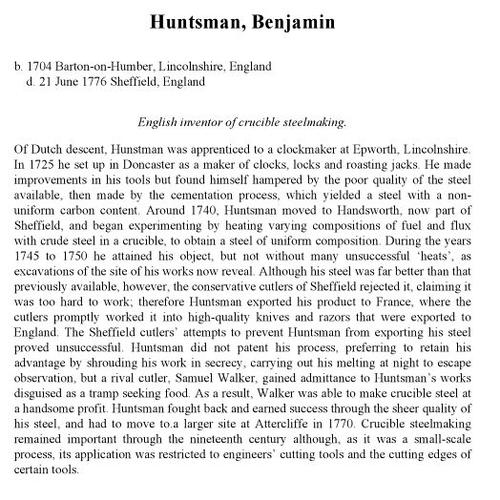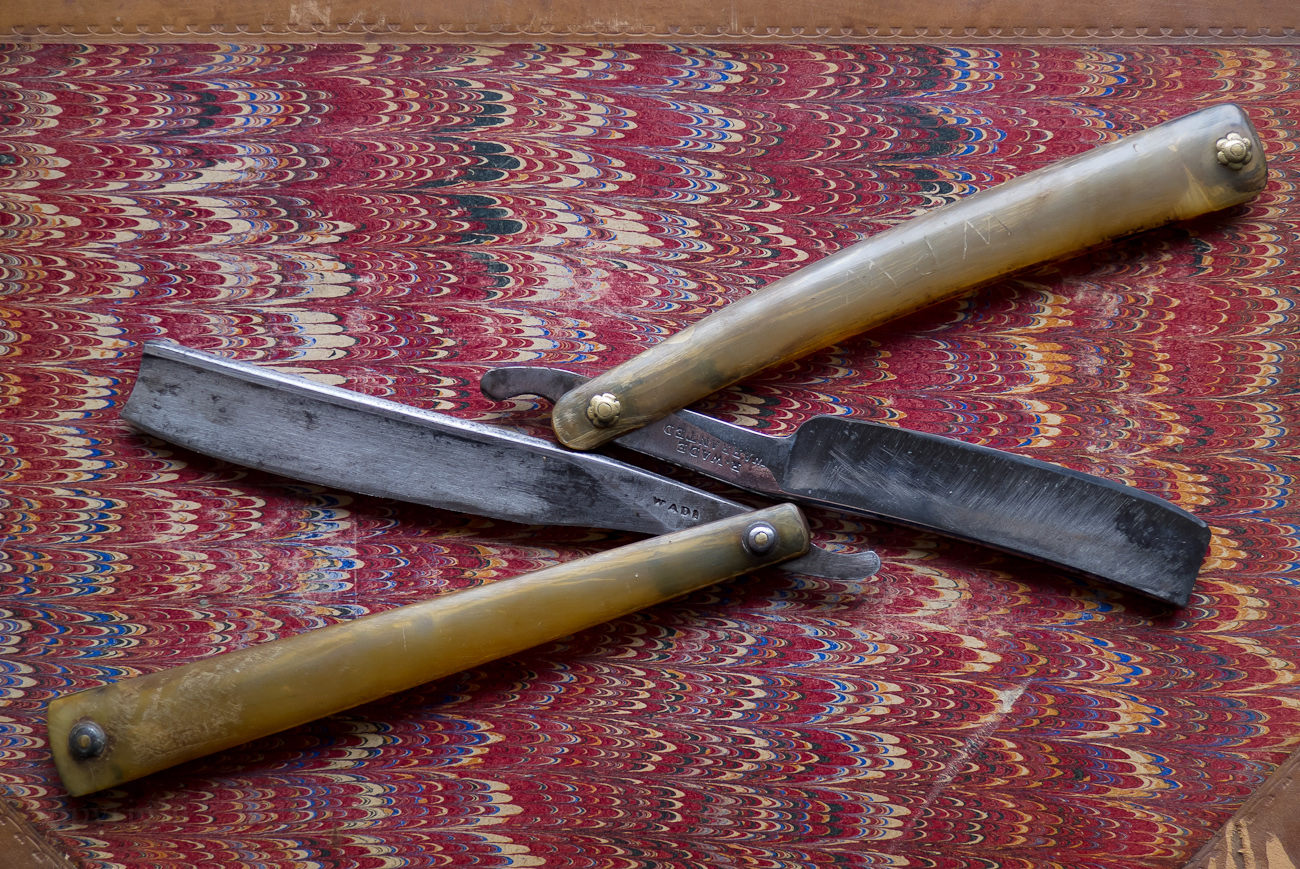Results 1 to 10 of 43
Thread: Straight razor history
Hybrid View
-
07-01-2013, 01:42 AM #1Member

- Join Date
- Mar 2011
- Posts
- 53
Thanked: 2 Straight razor history
Straight razor history
I have been trying to find history on the early straight razors. From what I have read, a gentleman named Benjamin Huntsman invented the cast steel razor. However, I do not see his name among any brand listings. Wikipedia is extremely vague (and not always reliable). It indicates that there was resistance to the modern razor in Britain, and it was more successful in France, though with a nationalist backlash. That is all I have been able to find out.
Would you please tell me more about Mr. Huntsman, and early razor manufacturers (18th century)?
Thank you.
-
07-01-2013, 01:58 AM #2Historically Inquisitive



- Join Date
- Aug 2011
- Location
- Upstate New York
- Posts
- 5,782
- Blog Entries
- 1
Thanked: 4249
You might find this interesting?

-
The Following 8 Users Say Thank You to Martin103 For This Useful Post:
fmlondon (07-01-2013), Frankenstein (07-01-2013), JimmyHAD (07-01-2013), pfries (07-01-2013), rolodave (07-01-2013), Steelystan (07-17-2013), Sunbird (07-01-2013), thebigspendur (07-01-2013)
-
07-01-2013, 02:22 AM #3

To the best of my knowledge Benjamin Huntsman didn't make any razors.
There are a lot of competing stories about the invention of his cast steel process, and it's pretty much impossible at this point to know where the truth lies. I love the shivering beggar story of Samuel Walker (enough that it's the name of my website!), but it's probably not true. Walker, to the best of my knowledge, didn't see the kind of success you'd expect if he'd stolen the process. That part of the story also doesn't precisely sit well with the part where Huntsman had to sell all his steel to France because the old Sheffield guys were hidebound.
These days I kind of wonder if that 'sale to France' part wasn't a story from London, which had quite the rivalry with Sheffield.
As for the earliest straight razors, I think this represents the earliest one I've seen. Yes, it's a painting, but from the school of Dutch still life that was meant to be as realistic as possible. It's easy to tell that razor had tortoise shell scales and a worked silver pommel (which seems to have been quite common on razors from the earlier part of the 18th century). If you look closely, you can also see that it has a long, functional tail.
Where was it made? Unknown. Probably Holland. If memory serves, the early razor on display at the Mayflower museum in Plymouth, MA is described as Dutch and looks a lot like that one.-Zak Jarvis. Writer. Artist. Bon vivant.
-
The Following User Says Thank You to Voidmonster For This Useful Post:
Frankenstein (07-01-2013)
-
07-01-2013, 02:53 AM #4Member

- Join Date
- Mar 2011
- Posts
- 53
Thanked: 2
From when is the painting?
-
07-01-2013, 02:56 AM #5

That all depends on what you mean by modern.
I think pretty much any of us could pick up the razor in van Hoogstraten's painting and shave with it. The chances are good that while the steel wouldn't hold its edge long, it was probably of reasonable quality. High quality steel was made long before Huntsman, but the processes tended to be secret and expensive. The very early razors, like the one in the painting, would have been items for the extraordinarily wealthy.
1667 give or take a year.-Zak Jarvis. Writer. Artist. Bon vivant.
-
07-01-2013, 02:59 AM #6Member

- Join Date
- Mar 2011
- Posts
- 53
Thanked: 2
So, is this a modern steel straight razor? Again, I know so little of the history. I have some iron razors, which look like miniature hatchets.
-
07-01-2013, 02:51 AM #7Member

- Join Date
- Mar 2011
- Posts
- 53
Thanked: 2
Thank you for the information. It looks as though the first actual modern straight razors were manufactured in France from Huntsman steel?
-
07-01-2013, 01:19 PM #8

If we want to go back in time, there are many examples of razors since the beginning of civilization. Folding straight razor as we know it today, it is an invention of the late 1700s and early 1800s.
The RazorGuy - StraightRazorChannel on Youtube and Google+
-
07-01-2013, 02:43 PM #9

Actually, the folding razor as we know it is the one I'm saying predates 1650. It's what Samuel van Hoogstraten painted, it's what the Pilgrim's carried to Plymouth, and I've seen several examples in batches of early 18th century auctions.
How did it differ from 1550 to 1650 to 1750? The examples are few and far between, and while it's very tempting to come up with an overview, I don't think there's enough evidence to do that. I'm away from my main computer (where I've stored pictures) and all but my digital library or I'd dig up some to show other than the painting.
My currently unsupported guess is that the folding razor probably was derived from the folding bistoury. There didn't used to be any kind of clear dividing line between surgeons and barbers, but until I can dig through my books on the history of medical instruments, that's just a guess.
Another thing that it's useful to be careful of is the idea that there was a clear progression of forms. I know Henry Lummus says razors before 1800 had tiny or non-existent tails, but I've found too many razors that break his rules of thumb. Remember, the cutlers were always trying the occasional odd, new thing as well as making traditional razors.
These razors (after 1814):

were made more recently than these (around 1810):

And of course, the French and the English did the tails on their razors very differently.-Zak Jarvis. Writer. Artist. Bon vivant.
-
The Following 4 Users Say Thank You to Voidmonster For This Useful Post:
fmlondon (07-01-2013), Frankenstein (07-02-2013), JimmyHAD (07-01-2013), MJC (07-03-2013)
-
07-01-2013, 03:03 PM #10

I went mining the internet for early razors and found a few.
1760's English, John Pyke.
18th century Spanish set (these give me a righteous case of the 'GIMMIES!')-Zak Jarvis. Writer. Artist. Bon vivant.
-
The Following User Says Thank You to Voidmonster For This Useful Post:
25609289 (07-03-2013)


 43Likes
43Likes LinkBack URL
LinkBack URL About LinkBacks
About LinkBacks






 Reply With Quote
Reply With Quote

